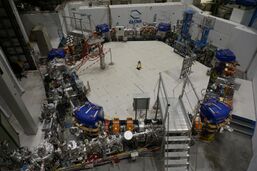Organization:Extra Low ENergy Antiproton ring (ELENA)
Extra Low ENergy Antiproton ring (ELENA) is a 30 m hexagonal storage ring that decelerates antiproton beams and delivers it to different AD experiments. It is situated inside the Antiproton Decelerator (AD) complex at CERN, Geneva.[1][2] It is designed to further decelerate the antiproton beam coming from the Antiproton decelerator to an energy of 0.1 MeV for more precise measurements.[3][4] The first beam circulated ELENA on 18 November 2016.[5] The ring is expected to be fully operational by the end of the Long Shutdown 2 (LS2) in 2021.
GBAR experiment (AD-7) was the first experiment to use a beam from ELENA, with the rest of the AD experiments following suit after LS2 when beam transfer lines from ELENA will have been laid to all the experiments using the facility.[6] Long Shutdown 2 (LS2) officially ended on July 5, 2022 with the beginning of LHC Run 3.[7] Antiprotons from ELENA have been available to the MUSASHI trap of the ASACUSA CUSP experiment from August 2021.[8]
ELENA decelerator
The AD and ELENA experiments require antiprotons of about 3 to 5 keV energy, suitable for trapping them in the Penning traps and carrying out further measurements. The AD outputs 5.3 MeV energy antiprotons which are then decelerated to ~5keV using the degrader foils by each of the experimental setups.
This results in a loss of about 99.9% of antiprotons. The ELENA ring with its efficient beam cooling and deceleration method is meant to increase the effective number of antiprotons that could be made available to the antimatter experiments by reducing the usage of the degrader foils.[1][9]
Efficiency of ELENA
ELENA will deliver antiprotons at 100 keV energy (compared to AD's 5.3 MeV beam energy). Beam cycle through ELENA ring is ~20 seconds long, while it decelerates antiprotons from 5.3 MeV to 100 keV. These antiprotons still require some further deceleration by the experiments themselves using the degrader foil. But a lesser amount of deceleration through degrading foils would ultimately increase the efficiency. Through ELENA, the ATRAP, ALPHA, and AeGIS experiments will get a two-fold increase in the number of antiprotons.[1][10] While the ASACUSA experiment, which uses radiofrequency quadrupole (RFQD), and an ultra-degrader foil for deceleration will receive a ten-fold increase in the number of its antiprotons.[1]
Unlike AD, which can deliver antiprotons to only one experiment at a time, ELENA is capable of delivering it to up to four experiments simultaneously. New experiments such as ReMi (Reaction Microscope) are therefore under the proposal.
Process of deceleration
The first step of deceleration in ELENA uses a radiofrequency cavity and brings down the energy of antiprotons from 5.3 MeV to ~0.65 MeV. During this step the beam is de-bunched and the electron-cooling method is used to decreases the beam emittance, allowing beam intensity preservation. At the end of this procedure, 0.65 MeV beam is re-bunched and further decelerated to 0.1 MeV by debunching it and by applying electron cooling.[2][11]
During the commissioning time period, AD being actively used by its experiments, its beams were not regularly available for ELENA's testing. Therefore, an ion source developed at Julich Forschungszentrum in Germany for producing [math]\ce{ H^- }[/math]and [math]\ce{ H^+ }[/math] ions was used.[12]
See also
External links
References
- ↑ 1.0 1.1 1.2 1.3 "ELENA – Home". https://espace.cern.ch/elena-project/sitepages/home.aspx.
- ↑ 2.0 2.1 Oelert, W. (2015). "The ELENA Project at CERN". Acta Physica Polonica B 46 (1): 181. doi:10.5506/APhysPolB.46.181. Bibcode: 2015AcPPB..46..181O.
- ↑ Jorgensen, L V; Nosych, A; Sanchez-Quesada, J; Harasimowicz, J; LeGodec, G; Angoletta, M E; Kuchler, D; Zickler, T et al. (2014) (in en). Extra Low ENergy Antiproton (ELENA) ring and its Transfer Lines: Design Report. doi:10.5170/CERN-2014-002. http://cds.cern.ch/record/1694484.
- ↑ Madsen, N. (2018). "Antiproton physics in the ELENA era". Phil. Trans. R. Soc. A 376 (2116): 20170278. doi:10.1098/rsta.2017.0278. PMID 29459419. Bibcode: 2018RSPTA.37670278M.
- ↑ "A new ring to slow down antimatter – CERN". http://home.cern/cern-people/updates/2016/11/new-ring-slow-down-antimatter.
- ↑ "Exceptionally slow antiprotons" (in en). https://home.cern/news/news/accelerators/exceptionally-slow-antiprotons.
- ↑ "LHC Run 3 Begins!". https://www.facebook.com/cern/videos/lhc-run-3-begins/2196716960494434/.
- ↑ "PROGRESS REPORT OF THE ASACUSA AD-3 COLLABORATION". https://cds.cern.ch/record/2799130/files/SPSC-SR-301.pdf.
- ↑ Bartmann, Wolfgang; Belochitskii, Pavel; Breuker, Horst; Butin, Francois; Carli, Christian; Eriksson, Tommy; Oelert, Walter; Ostojic, Ranko et al. (2018-02-19). "The ELENA facility". Philosophical Transactions of the Royal Society A: Mathematical, Physical and Engineering Sciences 376 (2116): 20170266. doi:10.1098/rsta.2017.0266. ISSN 1364-503X. PMID 29459416. PMC 5829171. http://dx.doi.org/10.1098/rsta.2017.0266.
- ↑ Gamba, Davide; Carli, Christian; Eriksson, Tommy; Ponce, Laurette; Tranquille, Gerard (2019). Kuzin, Maksim V. (Ed.), Schaa, Volker RW (Ed.). "ELENA Commissioning" (in en). Proceedings of the 12th Workshop on Beam Cooling and Related Topics COOL2019: 3 pages, 8.376 MB. doi:10.18429/JACOW-COOL2019-WEX03. ISSN 2226-0374. https://jacow.org/cool2019/doi/JACoW-COOL2019-WEX03.html.
- ↑ Tranquille, Gerard; Cenede, Jean; Frassier, Alexandre; Jørgensen, Lars; Kolehmainen, Antti; Moles, Benjamin; Timmins, Marc (2016). Petit-Jean-Genaz Christine (Ed.), Kim, Dong Eon (Ed.), Kim, Kyung Sook (Ed.), Ko, In Soo (Ed.), Schaa, Volker RW (Ed.). "The ELENA Electron Cooler" (in en). Proceedings of the 7th Int. Particle Accelerator Conf. IPAC2016: 3 pages, 0.990 MB. doi:10.18429/JACOW-IPAC2016-TUPMR006. http://jacow.org/ipac2016/doi/JACoW-IPAC2016-TUPMR006.html.
- ↑ Megía-Macías, A.; Gebel, R.; Lefort, B. (2018-09-21). "The ion source for the commissioning of ELENA ring". AIP Conference Proceedings 2011 (1): 090014. doi:10.1063/1.5053395. ISSN 0094-243X. https://aip.scitation.org/doi/abs/10.1063/1.5053395.



